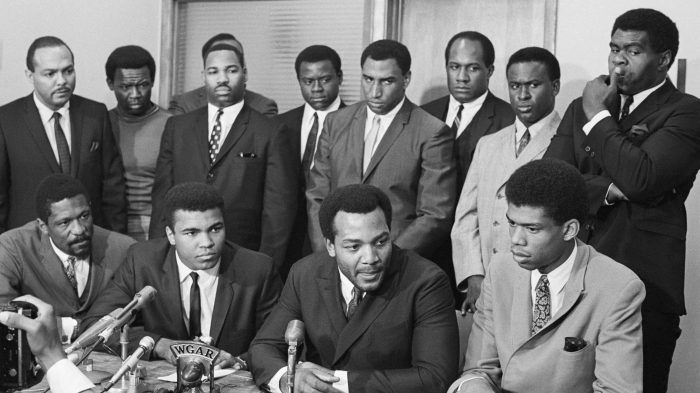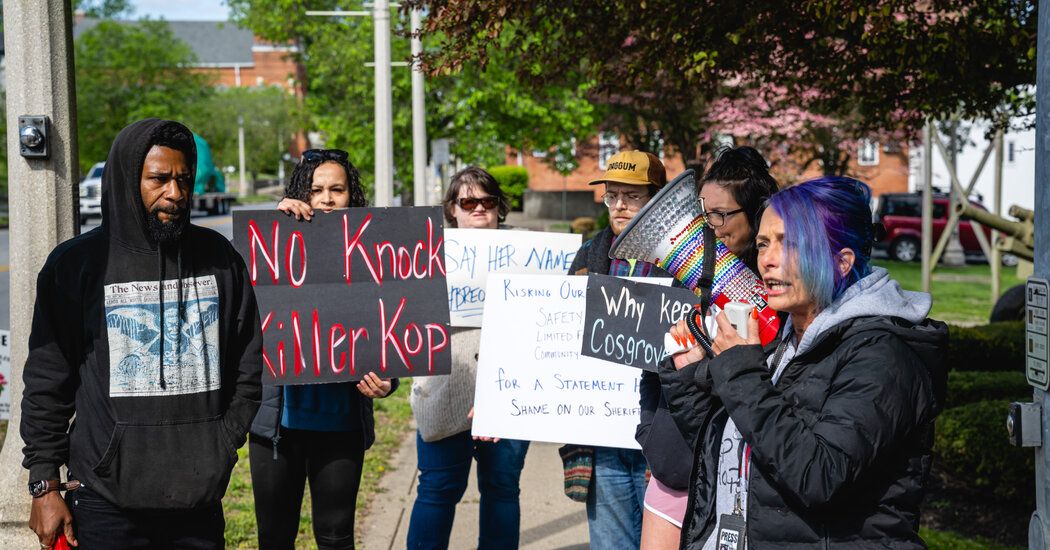Jim Brown’s legacy, as told by his Cleveland Browns teammate John Wooten: ‘He never thought the job was finished’
The nation’s top African American athletes gathered for a meeting at the Negro Industrial and Economic Union to hear Muhammad Ali’s view for rejecting Army induction. Front row (from left to right): Bill Russell, Ali, Jim Brown and Lew Alcindor. Back row (from left to right): Carl Stokes, Walter Beach, Bobby Mitchell, Sid Williams, Curtis McClinton, Willie Davis, Jim Shorter and John Wooten.
On June 4, 1967, the Cleveland Summit, which is also referred to as the Muhammad Ali Summit, occurred on the East Side of Cleveland. Legendary former NFL superstar Jim Brown, who had retired from the league about a year earlier while still in his prime, organized the meeting in support of Ali, who had been stripped of his heavyweight World Boxing Association title in April and had his boxing license suspended after he refused to be drafted into the military based on his religious beliefs and his ethical opposition to the Vietnam War. Later in June, Ali would be convicted of draft evasion, sentenced to five years in prison, fined $10,000 and required to surrender his passport (he would remain free on appeal until the Supreme Court overturned his conviction in 1971 in a unanimous 8-0 decision).
In the first meeting of its kind, Brown brought together some of the most prominent African American athletes of the time – including Boston Celtics great Bill Russell and UCLA basketball superstar Ferdinand Lewis Alcindor Jr., who later changed his name to Kareem Abdul-Jabbar – and one Black politician to question Ali about his convictions and, ultimately, back him. The meeting proved to be a watershed moment in Black athlete empowerment, and it produced the iconic photo above.
NFL offensive lineman John Wooten, a longtime Browns teammate of Brown’s, is pictured in the second row standing behind Alcindor. In the wake of Brown’s death, Wooten, his close friend of more than 60 years, reflected on the legacy of a giant in the arenas of football and civil rights.
When you look at that picture, that picture that so many people still talk about today, you have to understand that meeting doesn’t happen without Jim. Just no way. Because of who Jim was, because of everything Jim was doing [in the Civil Rights Movement of the day], he had so much respect in the NFL and with all [prominent Black athletes]. If there was something Jim was doing to help kids get jobs, help get programs going to educate kids and try to improve their situations, Jim could get anyone on the phone and get their help.
That meeting came together because Jim saw a need and went to work. That’s the way he was. Jim saw what was going on, he saw a need for change, and he went to work to try to change things. With what Ali was going through, Jim wasn’t just going to sit back and watch that. After Jim asked the right questions, he knew Ali needed our support. And he got it. That’s the approach Jim took with everything: Ask the right questions, figure out what needed to be done and then go out there and do it.
As we became friends there with the Browns, Jim got to the Browns in ’57 and I got there in ’59, the thing he would always tell me is, Woot, we can’t stand on the sidelines. We just can’t sit back and do nothing with all this [the movement] going on. That was the theme that he talked about all the time; Find a way to help. He thought about it all the time. And then I remember one day he says to me, Woot, we’re not gonna march. We’re not gonna [be part of sit-ins]. But we’ve got to be involved in a serious way in the Civil Rights Movement.
What we did, what Jim put his time and energy into, was coming up with programs for education and economic empowerment. Jim saw those areas as places he could use it [his platform as one of the nation’s most recognizable people] to make change. Jim understood that education and economic improvement would be keys for overall improvement in the future. There were so many things that could be done, so many things that needed to be done, and Jim saw those areas as the best place to put all of his energy into.
Boxer Muhammad Ali (left) with his friend Cleveland Browns running back Jim Brown (right) as Ali arrives for a meeting with the Illinois Athletic Commission on Feb. 25, 1966, in Chicago. Bettmann/Getty Images
Jim wasn’t concerned about [potential pushback from people opposed to civil rights for African Americans]. Jim stood up for what he believed was right. And that was something Jim never backed away from. He just believed that if you had the ability to help, especially help pull up young people, that you had an obligation to do it. He was proud and determined. He was committed to helping. And think about that. Jim would have been fine if he just focused on football and just focused on himself.
Jim didn’t have to take on what he did. He did what he did to help people who didn’t have the same influence as he did, and he never worried about the risks, because that was the right thing to do. So many conversations we had through the years, through the decades, about things we were proud of that we had done, things we worked hard on, but Jim knew there was so much more work that needed to be done. He never thought the job was finished. He knew it wasn’t.
I think back to when I was a rookie in ’59 and Black players and white players still weren’t allowed to room together on the road. That’s just the way it was. My rookie year, the Browns had seven Black players on the team. I was the odd player out, so I roomed by myself. It didn’t make any sense. Jim didn’t have to be concerned about me. He was the league MVP. But Jim was tired of the policy. He knew it was wrong. And it just didn’t make sense from a business standpoint. We wound up having me and one white player each having their own rooms on the road. Jim was tired of [the policy].
He went to [Browns coach] Paul Brown and explained that the policy just didn’t make sense. Clearly, Paul Brown hadn’t thought about it from a cost standpoint. And after Jim talked to him, to his credit, Paul Brown understood why it would make sense to change the policy. Paul Brown also understood it would help bring the team closer together. Paul Brown was different from a lot of coaches at the time because he could see over the mountain. On that whole thing with the rooms, Jim helped him get there. Jim was the only one who could have done that. With so many things he did, Jim was the only who could have done it.
Wooten played 10 seasons in the NFL (his first nine with the Cleveland Browns) and was a two-time Pro Bowler. After a brief stint as a sports agent, Wooten returned to the league and climbed the corporate ladder in scouting with the Dallas Cowboys, eventually occupying a top position in their personnel department. Later, with the Philadelphia Eagles, Wooten held the title of vice president of player personnel.
Following his retirement as an NFL executive, Wooten had a long run as the chairman of the Fritz Pollard Alliance, the independent advocacy group that arose from the struggle to recognize Pollard – the NFL’s first Black star player, first Black quarterback and first Black head coach – in the Pro Football Hall of Fame.
Source: Andscape


